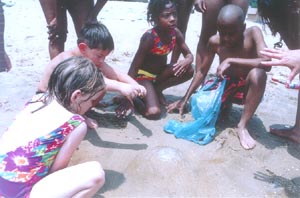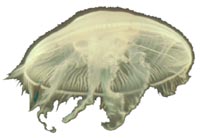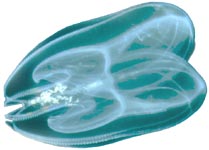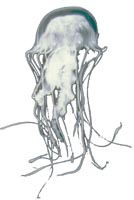 Bay
Life
Bay
LifeHunting the Stinging Jellyfish
Once again this year, they'll come
by Leda Rose
 Bay
Life
Bay
Life
Hunting the Stinging Jellyfish
Once again this year, they'll
come
by Leda Rose
Kids at North Beach gather around a washed-ashore sea nettle and learn of the harm its tentacles can inflict.
I was at North Beach dividing my eyes between hunting shark's teeth among the pebbles and making sure my kids didn't drown. Then I heard the yell.
"Ouiii! I got stung!" A girl hobbled to the shore. Her mom rushed to investigate.
"There it is. It's a jellyfish!" Came a second yell from a boy standing in the water's gravely edge.
I stood up to spot my kids and shouted for them to scram to dry sand. The boy, now next to me, was excitedly yelling to other boys drawn by the prospect of seeing a real jellyfish. Soon they were all shouting instructions at each other. The spotter promised death to the vile creature that "bit my sister!" I was amused at the gallantry - and concerned for the girl.
"Tommy, get the bucket!"![]()
"I'll get the rake, you get that stick!"
Even my six-year-old son joined the posse. It swelled to a mob of six to eight boys. All looked less than 10 years old. But the hunters were quick to act and worked as a team led by the brother, who was also the oldest. The monster never had a chance as they sloshed it into the bucket and dumped it on the hot sand for a closer look.
I like to think it died quickly.
Most of the boys didn't relish the kill as much as a chance to see the monster up close. Nevertheless, I had flashes of a black and white version of Lord of the Flies I'd seen in eighth grade.
 Jellies Ahead
Jellies Ahead
That was last year. This year, even the weatherman says we can expect the Bay to be thick with jellyfish. The extreme drought caused higher salinity levels in the Bay, which is an ideal environment for a proliferation of stinging sea nettles, aka Chrysaora Quinquecirrha.
This year, we plan to hit the beach early in the day to avoid the jellies that come in on the afternoon tides.
"Any Calvert County resident knows, 'You can't swim after the Fourth of July!' Thus quips Denise Breitburg of the Academy of Natural Sciences Estuarine Research Center in St. Leonard.
Over the Fourth of July weekend, Ray Glover reported jellies as big and plentiful off his Patuxent River dock midway up Calvert County. Until then they had not prevented swimming or waterskiing.
That was before the Fourth of July.
The drought also contributes to lower oxygen levels, resulting brackish waters throughout the Bay. This I learn from Breitburg, whose office is only a couple of miles from Glover's dock.
Low oxygen concentrations create an environment in which jellyfish appear to have the advantage, Breitburg explains. She and her colleagues, Mary Beth Decker and Jennifer Purcell - of the Center for Environmental Studies, across the Bay in Cambridge - are in the early phases of a study, funded by the EPA. They are investigating the amazing ability of sea nettles to survive very low oxygen conditions.
"Low oxygen, caused by high nutrients, might encourage growth more favorable for sea nettles and comb jellies. Both are very tolerant of low oxygen - more than fish are," says Breitburg. Jellies can tolerate oxygen levels as low as 10 percent of normal amounts found in surface waters, according to Breitburg's findings thus far.
"They survive for several days under those conditions. Most fish would not have survived. Many would have been killed very quickly," Breitburg says.
With rain 30 percent below normal and summer barely begun, fish are dying by the thousands from oxygen starvation. By the first days of July, an estimated 200,000 fish had died, many in Anne Arundel County. Jellies will do just fine.
Armed and Ready to Sting
So do humans stand a chance against these strange, resilient creatures?
The posse at North Beach didn't have much to fear beyond a few stray stingers. After all, jellyfish are about 90 percent water. They don't have brains, eyes, ears, gills or a heart. They feed voraciously on comb jellies, small fish and other creatures, but these shapeless critters don't have it in them to attack people, like, say a shark.
They float along on water currents or gently propel themselves through the water. Humans get stung if nematocysts happen to come into vigorous contact with an arm or leg thrashing in the water.
"Sea nettles are more of a nuisance than anything else," says Wayne Suydam, a ranger at Sandy Point State Park.
"We've only seen a few come into our waters so far," added Fran Gower, also at Sandy Point. "They will probably start coming in the middle of July. The fresh rain we've had lately will keep them a bit farther south for now."
Gower, who has been a ranger for 15 years, says that so far the number of jellies seems "pretty normal."
"But the lack of rain has a tremendous effect. Like last year; we didn't get much rain last year, either. Once they got here, they seemed to be here in force, in pretty large quantities."
At Sandy Point, in the Middle Bay where jellies are often the thickest, rangers post warning signs and sympathetic lifeguards suggest a cold shower for stings. But the rangers really don't see jellies as much of a problem.
"We only have a problem when a person has an allergic reaction. We call the paramedics. That happens about once a year," Suydam said. "Most people just have a little discomfort and swelling or redness on the skin."
Curing the Sting
Bay swimmers who just can't stay out of the water despite spotting jellies can take precautions. Lycra gear, rubberized diving suits and even pantyhose can prevent contact. A slathering of petroleum jelly works, too.
Breitburg cautions that tentacles can trail as long as six feet in the ever-moving water. Each tentacle can have thousands of harpoon-like 'nematocysts' or stingers.
The venom comes from a hollow coiled thread with barbs lining its surface. Nematocyst triggers are activated at touch. Pressure within the nematocyst forces the stinging thread to rapidly uncoil. "The thousands of nematocysts act as small harpoons, firing into prey, injecting paralyzing toxins," according to the the South Carolina Department of Natural Resources.
While small creatures are paralyzed or killed, humans are likely to be only irritated.
Even beachcombers aren't home free. Free-floating and fragmented tentacles wash ashore, especially after heavy storms. Kids form hunting parties to capture a jelly. Even dead jellies can still sting.
When you are stung, you'll know it. But there are lots of theories about what to do.
"Symptoms are a rash with pain and red streaks where [the tentacle] touches you. The rash goes away in about 45 minutes. The pain lasts for several hours," said Dr. Joseph Burnett, chief of dermatology of University of Maryland Medical Center.
It's folk wisdom that meat tenderizer absorbs venom and relieves swelling.
Burnett has spent the past 30 years studying jellyfish and is fascinated by the structure of their stinging mechanisms. After countless stings and tests of ointments and remedies, he's grown weary of refuting the meat tenderizer theory.
"The guys in the Indian Ocean started that whole thing over there. This jellyfish has injected that stuff into your skin, and a topical application just isn't going to work," Burnett counters.
How about papaya? Wind surfer Roger Jackson of Scotland, Md. swears by fresh papaya, from which comes the prime ingredient in tenderizers, papain. "When smushed into a paste and applied to the affected skin area, fresh papaya provides the most dramatic 'cure' I've witnessed," says Jackson. "Even more dramatic is the rapid disappearance of any welts associated with sea nettle exposure."
If you ask Burnett, it's probably a placebo effect.
He advises that the best way to get the slime and sting off - if not stop the pain - is a baking soda poultice. "Baking soda," he says, "will stop the nematocysts from firing. If you want to stop the pain, you've got to do it by taking a pain reliever."
Burnett also edits the Jellyfish Sting Newsletter, which he started about 10 years ago. "It's really for professionals in the field," he says, "but you can look it up on the James Cook University web site."
If it's pain relief you want rather than information, take two aspirin. Call a doctor in the morning if you're still in severe pain. You could be having a more serious allergic reaction.
The Good in Nettles
Despite this season's expected glut of jellies, long-term population counts indicate that sea nettles have declined in the Bay over the past several decades, Breitburg says. This is of some concern because there is speculation that sea nettles play a role in the food chain, affecting the oyster population.
"There is a qualifier on the current idea about the interaction of these species. This is the way we think the food web works but it has not been absolutely proven," Breitburg says. Under the category of truth is stranger than fiction: Sea nettles swallow oyster larvae and spit them right back out unharmed. Comb jellies gobble them up. Breitburg says that it is not proven why. Perhaps oyster larvae have thick shells and the sea nettles can't sting through them.
"But what we do know is that sea nettles are not efficient at digesting or killing them," Breitburg says.
"In contrast, comb jellies catch and digest the larvae readily," reports University of Maryland's Marine Notes web site.
"Comb jellies are also a favorite food of sea nettles, and they reduce comb jelly populations to zero in the tributaries during the summer when oyster larvae are most abundant," writes Jennifer Purcell of the University of Maryland Center for Environmental Science. "Therefore sea nettles appear to protect oyster larvae from a major predator."
So, as we wait to see just how strong the sea nettle population will be this season, maybe I'll get the kids hooked on hunting something really cool. You were thinking shark's teeth, maybe?
A Webfull of Jellies
Surf the web for more detailed information about sea nettles and other kinds of jellyfish.
Tennessee Aquarium, hosts a special exhibit about jellyfish at the aquarium in Chattanooga. Beautiful graphics: w.tennis.org/special/ecnettle.html.
University of Maryland Marine Notes. Covers many aquatic topics; jellyfish pages are back issues: www.mdsg.umd.edu/MarineNotes/Jul-Aug 94.
South Carolina Dept. of Natural Resources: http://water.dne.state.sc.us/marine/pub.
| Issue 27 |
Volume VII Number 27
July 8-14, 1999
New Bay Times
| Homepage |
| Back to Archives |